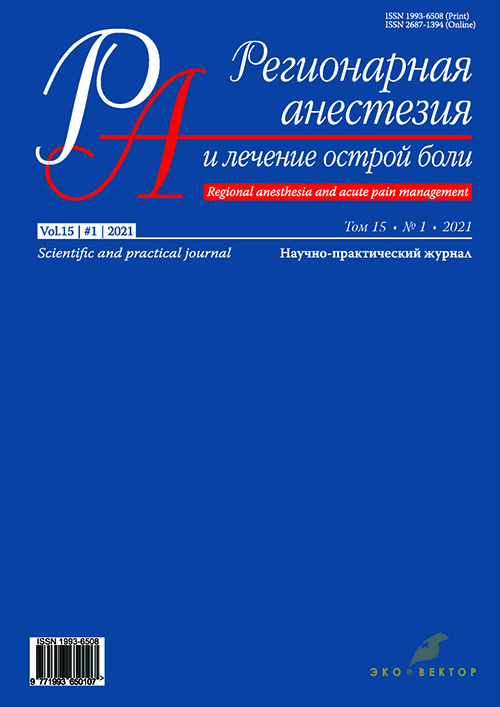Лечение постпункционной головной боли
- Авторы: Глущенко В.А.1, Груздов М.С.1, Попель И.В.1, Розенгард С.А.1
-
Учреждения:
- Национальный медицинский исследовательский центр онкологии имени Н.Н. Петрова
- Выпуск: Том 15, № 1 (2021)
- Страницы: 63-66
- Раздел: Клинические случаи
- Статья получена: 10.07.2021
- Статья одобрена: 10.07.2021
- Статья опубликована: 15.01.2021
- URL: https://rjraap.com/1993-6508/article/view/75951
- DOI: https://doi.org/10.17816/RA75951
- ID: 75951
Цитировать
Полный текст
Аннотация
В статье приводится описание клинического случая успешного применения трансназальной блокады крылонëбного узла для лечения постпункционной головной боли. В работе обсуждаются условия применения данной методики, механизм её действия и результаты. Учитывая простоту технического выполнения блокады крылонëбного узла и практически отсутствие противопоказаний к еë применению, за исключением случаев индивидуальной непереносимости препаратов местных анестетиков, она может являться эффективным методом в комплексной терапии постпункционной боли.
Полный текст
Об авторах
Владимир Анатольевич Глущенко
Национальный медицинский исследовательский центр онкологии имени Н.Н. Петрова
Автор, ответственный за переписку.
Email: spbgmaanestez@mail.ru
ORCID iD: 0000-0003-2638-5853
SPIN-код: 1274-9977
д.м.н., профессор, заведующий научным отделением анестезиологии, реаниматологии и алгологии
Россия, 197758, Санкт-Петербург, ул. Ленинградская, 68Максим Сергеевич Груздов
Национальный медицинский исследовательский центр онкологии имени Н.Н. Петрова
Email: m.s.gruzdov@mail.ru
ORCID iD: 0000-0001-7565-4808
врач-анестезиолог
Россия, 197758, Санкт-Петербург, ул. Ленинградская, 68Ирина Валентиновна Попель
Национальный медицинский исследовательский центр онкологии имени Н.Н. Петрова
Email: ira.popel.64@mail.ru
ORCID iD: 0000-0003-4295-549X
к.м.н., врач-анестезиолог
Россия, 197758, Санкт-Петербург, ул. Ленинградская, 68Сергей Аркадьевич Розенгард
Национальный медицинский исследовательский центр онкологии имени Н.Н. Петрова
Email: rozengard.s@mail.ru
ORCID iD: 0000-0002-5042-830X
к.м.н., заведующий отделением анестезиологии и реанимации
Россия, 197758, Санкт-Петербург, ул. Ленинградская, 68Список литературы
- Diener H.C., Bendig M., Hempel V. Postpuncture headache // Fortschr Neurol Psychiatr. 1985. Vol. 53, N 9. P. 344–349. doi: 10.1055/s-2007-1001978 (In German).
- Arevalo-Rodriguez I., Munoz L., Godoy-Casasbuenas N., et al. Needle gauge and tip designs for preventing post-dural puncture headache (PDPH) // Cochrane Database Syst Rev. 2017. Vol. 4, N. P. CD010807. doi: 10.1002/14651858.CD010807.pub2
- far.org.ru [интернет]. Клинические рекомендации Федерации анестезиологов и реаниматологов «Постпункционная головная боль». 2018 г. [дата обращения: 20.01.2021]. Доступ по ссылке: http://far.org.ru/recomendation?download=88%3Apunctheadache .
- Боровских Н.А., Розенгард С.А. Факторы риска развития постспинальных головных болей // Вестник Санкт-Петербургского университета. Медицина. 2006. № 1. C. 102-109.
- Sluder G. The role of the sphenopalatine ganglion in nasal headaches // NY State J Med. 1908. Vol. 27. P. 8–13.
- Grant R., Condon B., Hart I., Teasdale G.M. Changes in intracranial CSF volume after lumbar puncture and their relationship to post-LP headache // J Neurol Neurosurg Psychiatry. 1991. Vol. 54, N 5. P. 440–442. doi: 10.1136/jnnp.54.5.440
- Kent S., Mehaffey G. Transnasal sphenopalatine ganglion block for the treatment of postdural puncture headache in obstetric patients // J Clin Anesth. 2016. Vol. 34, N. P. 194–196. doi: 10.1016/j.jclinane.2016.04.009
- Dubey P., Dubey P.K. Intranasal lignocaine spray for sphenopalatine ganglion block for postdural puncture headache // Saudi J Anaesth. 2018. Vol. 12, N 2. P. 364–365. doi: 10.4103/sja.SJA_680_17
Дополнительные файлы








